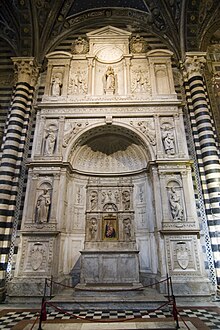Piccolomini Altarpiece

The Piccolomini Altarpiece is an architectural and sculptural altarpiece in the left-nave of
History
The cardinal

Todeschini commissioned Andrea Bregno to construct the altar. Bregno worked from 1481 to 1485, as evidenced by the inscription "OPUS ANDREAE MEDIOLANENSIS MCCCCLXXXV" under the central niche where the altar's Madonna and Child are now located.[1] Bregno, however, did not realize the marble altarpiece that was meant to frame the c. 1390 Madonna of Humility painting by Paolo di Giovanni Fei and the 14 statues "in the round" that were meant to fill the various niches and spaces of the altar. The original project included these elements but by 1486, Bregno, now in his 70s, had a breakdown in his physical help. He therefore returned to Rome, leaving the altar incomplete. From then on, only assistants from his workshop labored on the central marble altarpiece, that would enclose the Madonna of Humility.
Given Bregno's departure, Todeschini began to look for sculptors that would be able to make the remaining 14 statues. In the end, he entrusted the work to Florentine Pietro Torrigiano.[1] But he made only the Saint Francis in the altar's upper left niche. The agreement between Todeschini and Torrigiano was broken for unknown reasons, which forced the Todeschini to find another artist.
On June 19, 1501, with the intercession of the banker Jacopo Galli, a contract was created with the young
In 1503, Todeschini was elected pope but died after only 26 days. His heirs convinced Michelangelo, in a new contract dated to October 11, 1504, to complete the statues and the altar enriched by four statues that are found in the lower niches on the sides, realized with the help of assistants. Despite the repeated requests of the Piccolomini family, they did not complete the other envisioned statues. As a result, the archbishop of Siena Francesco Bandini Piccolomini annulled the contract in the 1530s. From then on, the Piccolomini lost interest in the altar, which has remained incomplete ever since.
At the end of the 18th century, the statue of Madonna and Child was placed in the altar's central niche. That statue was believed, until recently, to be the work of the young
Description
The architectural structural of the altar was inspired by the altarpiece made by Bregno in Rome's Santa Maria del Popolo, with a large niche containing the true altar and surrounded by a triumphal arch. The decoration in bas-relief contains motifs like festoons, garlands, cornucopias, vases, palms, candelabras, winged heads, dolphins, and tridents, among others. The decorations also include numerous half moons, which refer to the coat of arms of the Piccolomini. The decorations higher up were executed with less care than those on the lower levels.
To the sides, above the clients' coat of arms, there is a double register composed of niches framed by lesene, which contain the statues. Two similar niches are in the cornice of the altar, and a larger, central tympanum niche contains the statue of Madonna and Child by Giovanni di Cecco. The Madonna and Child predates the altar by over a hundred years.
Originally, there would have been 14 statues representing all the saints dear to the clients, the Piccolomini family and the city of Siena. Six in the side niches, three in the central niche where the Madonna and Child is now, two on the side pedestals above the cornice, and three on the three pedestals above the tympanum. These were never completed, however.
The remaining statues are, below and on the left side:
- Saint Peter by Michelangelo
- Saint Augustine by Michelango (later modified to represent Saint Pius
- Saint Francis by Pietro Torrigiani, possibly modified by Michelangelo
At right and on the lower level, there are:
- Saint Paul by Michelangelo
- Saint Gregory by Michelangelo
The central altarpiece painting of the Virgin Mary was a c. 1390 painting of Paolo di Giovanni Fei. Its marble altar frame has received less critical attention because it is believed to have just been the work of Andrea Bregno's workshop.
See also
Bibliography
- (in Italian) Umberto Baldini, Michelangelo scultore, Rizzoli, Milano, 1973.
- (in Italian) Toscana. Guida d'Italia (Guida rossa), Touring Club Italiano, Milano, 2003.
- "Scrubbed up Michelangelo sculptures draw Siena visitors". Italy Magazine. 18 May 2009. Retrieved 26 February 2021.
- "The Statues of Michelangelo". The Italian Tribune. 31 May 2018. Retrieved 26 February 2021.
- Istraëls, Machtelt (2010). "Sassetta and the Guglielmi Piccolomini altarpiece in Siena". The Burlington Magazine. 152 (1284): 162–171. JSTOR 40601389. Retrieved 26 February 2021.
References
External links
- WGA entry
 Media related to Altare Piccolomini at Wikimedia Commons
Media related to Altare Piccolomini at Wikimedia Commons
